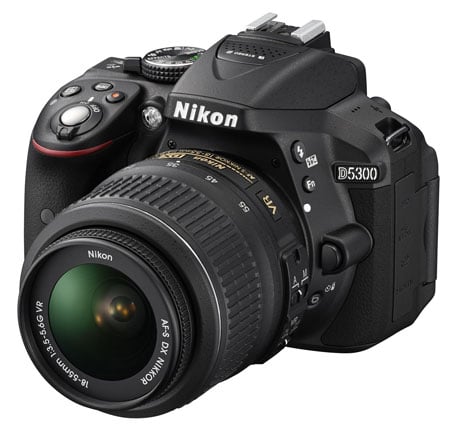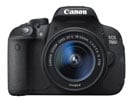Nikon D5300 review
-
-
Written by Ken McMahon
Verdict
The Nikon D5300 is quite an exciting development in Nikon’s DX line-up for a number of reasons. Following on from the D7100, it’s the second Nikon APS-C DSLR to omit the optical low-pass filter in front of the sensor and I’d be surprised if that isn’t a trend that continues to spread to other models, certainly if the quality of the images it produces is anything to go by.
Next, it has built-in GPS and Wi-fi, a first for any Nikon DSLR, though in the past you could of course plug in accessories for these features. Wi-fi connectivity isn’t just the future, it’s very much here and now, but where point-and shoot and compact system cameras have taken the lead, DSLRs have been slow to follow. It’s a little disappointing that the D5300’s wi-fi adds little to the basic functionality previously provided by the WU-1a dongle on earlier models, but it’s still good to see wi-fi and GPS built-in to a consumer DSLR and hopefully things like direct upload to photo sharing and social networking sites will quickly follow.
Nikon hasn’t ignored the picture-taking side of things either. With a bigger optical viewfinder and a larger LCD screen, composing and reviewing shots is a very much improved experience. The D5300 is the only model in the current line-up to offer a flip-out screen and the new 3:2 proportions are much better suited to displaying the D5300’s 3:2 stills images. Finally, there’s a new 1080p60 video mode with higher quality encoding across the board providing better quality video as well as the option for high quality half-speed slow motion playback when edited. The only drawback being that the time-limit for a continuous clip is reduced to 10 minutes at the best quality setting. The ability to take a ‘clean’ graphics-free’ feed from the HDMI port will appeal to serious videographers, as will the external microphone port.
With a couple of headline features guaranteed to get your attention, plus other significant enhancements the D5300 looks to be very tempting proposition. It’s not without its faults though. Some of these could be addressed by updating the slow and noisy kit lens to something that does better justice to the sensor and focussing. The D5300’s menu system is well designed and reasonably accessible, but useability – not to mention selection of manual AF points – would be hugely improved by a touch screen. And there’s still the handling issue of the info screen which, in the absence of an eye sensor is a distraction. Finally, the battery life isn’t impressive to begin with and use of the GPS and wi-fi reduces it considerably, making the lack of a battery grip accessory a real issue. But for most people these will be fairly minor drawbacks which don’t take the shine off an otherwise a sparkling performer. So before my final verdict lets see how the D5300 shapes up against its main competitor, the Canon EOS T5i 700D.

Compared to Canon EOS T5i 700D

The Canon EOS T5i 700D is Canon’s upper entry level DSLR and a direct competitor for D5300 which is around 15 to 20 percent more expensive. It’s a little larger and a little heavier than the D5300 and feels a little more robust.
The most obvious difference internally is the sensor resolution. Both models have APS-C sized sensors but the Canon has 18 Megapixels against 24 Megapixels on the Nikon D5300. Ordinarily you’d expect the higher pixel density on the D5300 to produce bigger images with worse noise, but my test showed that the opposite was in fact the case and the D5300 beats the T5i 700D on noise performance across the sensitivity range. The other big difference is that the D5300 lacks an optical low pass filter, and in my test results this appears to add to the quality edge that the D5300 enjoys over the T5i 700D with sharper edges and a higher level of overall detail.
Another difference between these models is in their respective AF systems – a conventional 39-point phase detect AF system on the D5300 vs a hybrid system on the Canon with both a 9-point phase-detect system with the mirror down and a hybrid system in Live view which uses both contrast-detect and phase-detect points on the sensor. Though the D5300 has a far greater number of PDAF points, all of the T5i 700D’s are cross type sensors and in practice there’s little difference in performance. In Live view mode and for movies, the T5i 700D’s continuous focussing is a lot quicker and surer and doesn’t hunt around anywhere near as much as the D5300 does.
The other factior that makes a difference to the focussing performance, especially during movie recording is the Canon’s touch-screen which you can just tap to set the AF point. But the influence of the T5i 700D’s touch-screen extends beyond focussing, making the Canon a much easier camera to get along with from a handling perspective. The touch screen makes getting to any of the settings a much more direct prospect than on the D5300 where you have to navigate menus using the control pad. Even without the touch-screen, the secondary controls on the T5i 700D’s four-way controller mean you can quickly get to white balance, AF mode and Picture style settings without sacrificing the ISO button or having to first navigate a menu as on the D5300.
Aside from the T5i 700D’s touch-sensitivity, in other respects the screens are very similar. The D5300’s updated screen now has the same 3:2 proportions and resolution as the T5i 700D’s and both are side-hinged and able to face in all directions including forward-facing for selfies.
In terms of continuous shooting, both cameras share the same 5fps speed. The T5i 700D will continue at that pace until the card is full, whereas the D5300 (like all Nikon cameras) stops after 100 shots, though you can continue with another 100-frame burst immediately. The metering system of the D5300 is certainly more sophisticated, with a 2016 pixel sensor compared to the 63-zone system of the Canon. But again when comparing Canon and Nikon DSLRs with the same metering systems, I wouldn’t say one has a noticeable advantage over the other.
The D5300 scores major points over the T5i 700D for its built-in wi-fi and GPS features. Though not ground-breaking, the D5300’s wifi implementation allows you to connect to an iOS or Android device and transfer images as well as remotely control the camera (albeit with a rudimentary level of control). This is a really nice benefit the latest Nikon models have over Canon ones until Canon either starts integrating wireless (as it has with the higher-end EOS 6D) or develops the EOS Utility to play nicely with Eye-Fi cards and run on mobile operating systems.
For video, again it’s quite closely matched with both models offering Full HD modes at 24 and 25 or 30fps, though the Nikon now also boasts a 1080p50/60 top quality option, a key advantage over all Canon DSLRs which top-out at 30fps for 1080p. Both have built-in stereo mics with contol over audio levels as well as a socket for an external mic. The T5i 700D also has the video snapshot feature which captures a series of short clips at predefined lengths of 2, 4 or 8 seconds and adds them all to an album. Added to that, the touch-screen focussing is something that can’t be underestimated. Countering that, and probably of more interest to serious videographers is the D5300’s ability to ouput a ‘clean’ signal free of graphics overlays via the HDMI port at 1080p resolution.
Assuming you have no existing tie to either Nikon or Canon, the choice between the D5300 and T5i 700D is a tough one. In terms of handling and performance they’re pretty closely matched. The T5i 700D’s touch-screen is one area that clearly differentiates them, as is the D5300’s built-in wi-fi and GPS. Another factor is price with the D5300 currently costing around 15 to 20 percent more than the T5i 700D in some regions. If the built-in GPS and wifi aren’t a big draw for you, the earlier D5200 could prove a bargain, though it also lacks the bigger screen and viewfinder as well as 1080p50/60 video modes of the newer model. Ultimately you’ll need to carefully compare the prices, pros and cons and choose the one which best suits your requirements.
See my Canon T5i 700D review for more details and also my Nikon D5200 review.
Nikon D5300 final verdict
The Nikon D5300 is what’s often referred to in the technology world as an ‘evolutionary’ upgrade. Nikon has abandoned the D5200’s optical low pass filter, which might have been considered revolutionary a year ago, but now looks, to borrow a fashion industry term, ‘on trend’. That’s not to say it’s frivolous or unwarranted, given that it improves the D5300’s image quality with no apparent drawbacks (Moire wasn’t an issue in any of my test shots) it’s absolutely the right move.
The introduction of built-in wi-fi and GPS is likewise something Nikon absolutely had to do and gives the company a lead, for the time being at least, over Canon. It’s a shame the D5300’s wi-fi implementation doesn’t stretch beyond the limited functionality of the WU-1a accessory, but it’s a start and hopefuly more interesting features like direct upload to websites will follow quickly.
Other improvements, including a bigger 3:2 proportioned flip-out screen, larger viewfinder and better quality video complete the picture, making the D5300 a tempting upgrade proposition for lower end and earlier Nikon DX model owners as well as a very compelling alternative to Canon’s EOS T5i 700D. The lacklustre wifi implementation was a disappointment but not enough to deprive the D5300 of a Cameralabs Highly recommended award, which it still very much deserves.
Good points
1037K-dot 3:2 proportioned flip-out screen.
Built-in Wifi and GPS.
1080p60 HD video mode.
Excellent image quality.
Bad points
No touch-screen.
Poor Battery life.
No viewfinder eye sensor.
Lacklustre wi-fi features.




